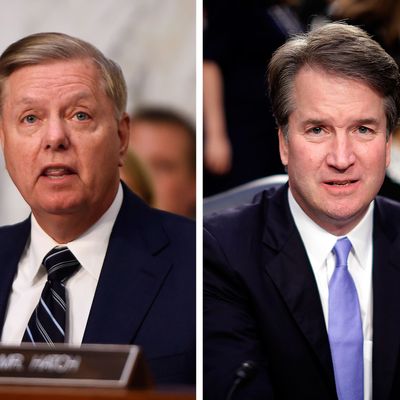
Throughout the confirmation hearings for Brett Kavanaugh, Democratic senators have challenged his acceptance of Roe v. Wade, the 1973 Supreme Court decision that established a constitutional right to an abortion. He’s become adept in reciting a sort of formula acknowledging (in language also used by Chief Justice John Roberts at his own confirmation hearing) Roe as “settled law” and an important SCOTUS precedent — and then refusing to answer questions about Roe’s original legitimacy (the key to a possible future reversal by SCOTUS itself, which is not bound to its own precedents the way lower courts are) because his answers might prejudge a future case.
But Republican Lindsey Graham threw Kavanaugh a curve today by asking him to criticize Roe on the standard grounds that conservatives like both of those men have heard (and almost certainly agreed with) thousands of times in their adult lives.
Graham went back to basics:
GRAHAM: Is there anything in the Constitution about the right to an abortion? Anything written in it …
KAVANAUGH: Senator, the Supreme Court recognized the right to an abortion in the 1973 Roe v. Wade case, and has reaffirmed it many times.
GRAHAM: Look, my question is, did they find a phrase in the Constitution that says the state cannot interfere with a woman’s right to choose, until medical viability occurs? Is that in the Constitution?
KAVANAUGH: The Supreme Court, applying the liberty —
GRAHAM: This is pretty simple: “No, it’s not, Senator Graham.”
KAVANAUGH (laughing): I want to be very careful …
GRAHAM: Will you tell me, yes or no, is there anything in the document itself talking about limiting the state’s ability to protect the unborn before viability? Is there any phrase in the Constitution about abortion?
Kavanaugh tried to talk about the Supreme Court’s interpretation of the constitutional “liberty cause,” but Graham wasn’t having any of it:
GRAHAM: What are the limits on the Court’s ability to find a penumbra of rights to apply in a particular situation? What are the checks and balances for people in your profession, if you can find five people who agree with you, to confer rights, whether the public likes it or not, based on this concept of a penumbra of rights? What are the limits to this.
Graham is alluding to the famous “penumbra” doctrine of unenumerated but implied rights contained in Justice Willam O. Douglas’s decision in Griswold v. Connecticut, the 1965 SCOTUS case that struck down a state ban on contraception as violating a right to privacy the Court had never explicitly identified before. It was, more importantly, the chief precedent cited by the Court majority in Roe v. Wade. Every American who has ever taken a constitutional law class knows all about Douglas, “penumbras,” Griswold, privacy rights, and Roe, and has heard the standard conservative complaint, echoed by Graham, that the whole thing is the epitome of illegitimate “judicial activism.”
But instead of agreeing or disagreeing with Graham, Kavanaugh tried to go off on a tangent about later Supreme Court cases about privacy rights being rooted in the country’s history and traditions. After mocking that idea, Graham got back to his basic objection of “five people” (justices) using “one word” (privacy) to “tell everybody elected in the country you can’t go there” (in restricting abortion).
GRAHAM: The only real check and balance is a constitutional amendment, to change the ruling. Would you agree with that?
This was a treacherous question, since most of the conservatives backing Kavanaugh would begin rioting in the streets if he conceded the Court had no power to “fix” Roe v. Wade. After a brief pause, Kavanaugh objected that he did not want to “comment on potential constitutional amendments,” and then mostly fell silent as Graham continued to offer the standard conservative rant about “judicial activists” robbing legislative bodies of their power to determine public policies. At the end, recognizing that Kavanaugh wasn’t going to comment, Graham concluded: “All I ask is that you think about it,” as though the veteran conservative jurist never had.
This near-comical exchange was revealing in that the well-rehearsed Kavanaugh had the discipline to act as though Graham, in enunciating tenets of liberal judicial overreaching that are part of his own philosophical inheritance, was handing him a rattlesnake to cuddle. There is no way Kavanaugh would have passed the Federalist Society vetting process if he didn’t at the very least broadly share Graham’s point of view about Roe. And if he is confirmed to the Court and blandly follows Roe as unshakable precedent, there will be hell to pay in conservative circles — from white-shoe law offices to small Evangelical churches — that will burn all the Republicans who voted to confirm him, and will even scorch Donald Trump if he is still in office at that point.
Everyone on the Judiciary Committee understands the deceptive game that he and Republican senators are playing on this subject. And that’s probably why Lindsey Graham felt secure in just making a speech to the galleries. But it seems to have given Brett Kavanaugh an uncomfortable moment, before he remembered the script he will follow until he is safely on the Supreme Court.






























